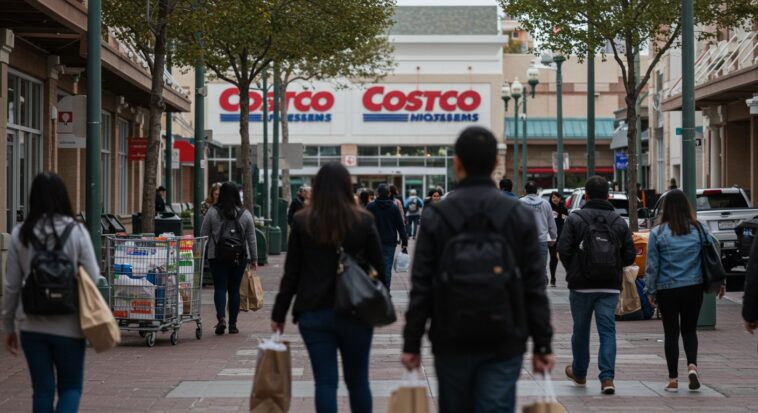In a market that’s constantly shifting due to inflation, interest rates, and global tariffs, consumers are changing their buying habits, and investors are having to rethink the brands they once trusted. So, which consumer stocks are worth keeping an eye on right now? They might not be the most glamorous names out there, but they’re the ones that are steadily holding their own.
“Brand loyalty is important, but margins and strategic focus are just as crucial,” explained Erin McAllister, a senior equity analyst at Eastbridge Capital. “Some companies are navigating this challenging environment with discipline, while others are struggling to keep up.”
Here’s a look at where analysts believe the smart money is heading—and which brands might be losing their shine.
Retail: Costco Stays the Course, Target Faces Storms
If retail were a marathon, Costco (NASDAQ: COST) would be way ahead of the pack. With more than 76 million paying members and a renewal rate exceeding 90%, this bulk retailer has created a stronghold built on loyalty and value. This strategy is proving to be a lifesaver as families become more discerning with their spending.
“Costco’s value proposition is rock solid,” noted McAllister. “When budgets are tight, people tend to downgrade, making Costco even more attractive.”
The company’s notoriously thin profit margins are balanced out by its membership model, which ensures a steady cash flow. Analysts still view it as a safe bet during uncertain economic times.
In contrast, take a look at Target (NYSE: TGT), whose brand image has taken quite a hit over the last year. After a chaotic retreat from its diversity and inclusion efforts—and an even less popular choice to eliminate its price matching policy—Target has seen its stock plummet by over 30% compared to last year.
“Target has pushed away its core customers just when it needs them the most,” said Rachel Tsang, a consumer sector strategist at Brighton Analytics. “It’s not just about political fallout—it’s also about operational blunders.”
Autos: GM’s Steady Road vs. Tesla’s Growing Potholes
In the world of cars, General Motors (NYSE: GM) has been steadily winning back the trust of investors. Over the last year, their shares have climbed by 21%. Although 2025 has started off a bit slow, analysts are still optimistic about the future. With a price target of $57.10, there’s potential for nearly 10% growth from where they are now.
“GM has always been a survivor,” noted Marcus Lee, a transportation equity researcher at Redpoint Markets. “They may not be the flashiest, but they’ve mastered the art of weathering economic cycles better than most.”
On the flip side, Tesla (NASDAQ: TSLA) is testing the limits of even its most devoted fans. The electric vehicle giant has seen a 25% drop in its stock this year, grappling with declining demand, stricter tariffs on parts from China, and the loss of electric vehicle tax credits in crucial markets.
“Tesla has shifted from being a disruptor to just another player in the automotive field,” Lee remarked. “In a landscape where cutting costs is more important than generating buzz, that’s not an ideal position to be in.”
Restaurants: Yum’s Global Appetite Beats Denny’s Local Struggles
Restaurants often feel the pinch when the economy takes a hit, and Yum China Holdings (NYSE: YUMC) has managed to ride out the storm so far. With popular brands like KFC, Taco Bell, and Pizza Hut in its portfolio, this fast-food giant has seen a remarkable 55% increase in its stock over the past year. Analysts credit this success to smart pricing strategies, a flexible supply chain, and a menu that appeals to customers no matter the economic climate.
“Fast, cheap, and familiar is exactly what consumers want right now,” Tsang noted. “Yum really understands that.”
In stark contrast, Denny’s (NASDAQ: DENN) has been struggling under the weight of inflation, particularly with essential items like eggs. The breakfast-focused chain has watched its stock tumble nearly 50% in the last year, now sitting at just under $4 a share.
“They’re trying to offer $3 breakfasts in a $6 egg economy,” McAllister joked. “That’s a tough recipe to keep going.”
With significant debt and shrinking profit margins, Denny’s is facing high risks in an already challenging industry.
Entertainment: Disney’s Diversification Pays Off, Six Flags Loses Its Spark
Disney (NYSE: DIS) is making a strong comeback, with a 25% increase in value over the past year. Its diverse empire—spanning theme parks, streaming services, and sports—provides a solid cushion against the ups and downs of specific sectors.
“Disney is like a well-balanced portfolio in itself,” Lee remarked. “If one division stumbles, another picks up the slack.”
The company is seeing a resurgence in international park attendance, and its streaming services are finally edging closer to profitability. Analysts predict that shares will see a modest rise over the next year, moving from $116 to about $130.
On the flip side, Six Flags (NYSE: SIX) has been having a tough time getting back to its pre-pandemic levels. Shares have dropped by 37% in the past year as theme park visits continue to lag behind. Management has pointed to rainy weather as a reason for the recent drop in attendance, but analysts believe the issue runs deeper.
“They haven’t modernized the experience or diversified their revenue,” Tsang noted. “When people have less money to spend on entertainment, Six Flags becomes an easy choice to cut.”
The Bottom Line: Know the Brand, But Know the Business Better
Warren Buffett is well-known for telling investors to “buy what you know.” But these days, just being familiar with a brand isn’t quite enough. To really succeed, brand equity needs to be supported by solid operations, strong pricing power, and smart strategic planning—especially in industries that have been hit hard by inflation, supply chain issues, and changing consumer attitudes.
Before you dive in, think about what makes a business truly resilient: loyal customers, consistent profit margins, manageable debt, and a strategy that doesn’t rely on perfect conditions or luck.
“The gap between winners and losers is getting bigger,” McAllister pointed out. “It’s not sufficient anymore to just own a recognizable name. You have to understand why that name will still be relevant in five years.”



